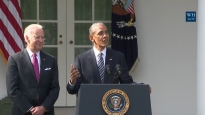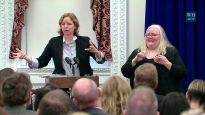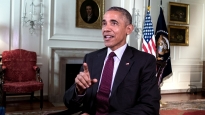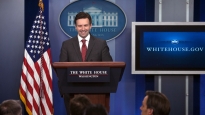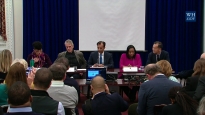Meeting of the President's Council on Jobs and Competitiveness
October 11, 2011 | 1:17:04 | Public Domain
Recommendations on creating jobs presented at third quarterly meeting in Pittsburgh, PA.
Remarks by the President in a Meeting with the President's Council on Jobs and Competitiveness
IBEW Local #5 Training Center
Pittsburgh, Pennsylvania
12:03 P.M. EDT
THE PRESIDENT: Well, let me just make a few remarks up front, and then really what I want to do is hear from all of you.
First of all, I had a chance to read the full report last night and I think it's outstanding. I think you guys did extraordinary work. Jeff, I want to thank you for your leadership on guiding this whole process. I think you have been steady and focused on how can we make sure that we're creating an economy that not only deals with the immediate problem of putting people back to work, but also how do we create a foundation for long-term opportunity for all people, and a growth agenda that is going to make sure that businesses are created here, that businesses stay here, and that they prosper here.
As I look at the introduction of the report, the quote that stands out, "We need a sense of urgency and a bias for action," is something that I think we all feel acutely. And the fact that you've been able to organize around five key steps that, I think, you'd be the first to acknowledge isn't all that needs to be done, but are key areas where we should be able to generate some strong bipartisan agreement and get action going quickly, I think makes it really extraordinary.
A couple of things I'll just remark on in terms of the general context. As you pointed out, I think at the beginning of this year, when we started the Jobs Council, I think all of us felt fairly confident that the economy could grow quickly enough that we could start bringing the unemployment rate down, even if it wasn't moving as quickly as we might like, but generally, the blue chip projections were somewhere between 3 and 4 percent growth.
We have had a very tough string of events over the course of the last 10 months. You had the Arab Spring, which shot up oil prices far higher than any of us anticipated. You've got the tsunami in Japan, which affected supply lines globally. You had, most prominently, the situation in Europe, which has created great uncertainty for businesses across the board. And then, unfortunately, Washington got involved in a self-inflicted wound with the debt ceiling fiasco. And all those things, I think, led to both consumers and businesses taking a big step backwards and saying, we are just not sure where this thing is going.
As a consequence, projections now in terms of growth are significantly lower than they were. And the situation in Europe, in particular, is one in which we're spending a lot of energy talking to our counterparts across the Atlantic, trying to make sure that they handle this in a way that stabilizes the economic situation in the coming months.
So we've had a string of events that have darkened the outlook, and that makes the action that -- the actions that are being recommended by the Jobs Council that much more important, because these are areas where we actually have control of the situation. We could do these things, and there's no doubt about the fact that it would have a significant, marked impact on job growth right now.
A couple of comments, and then what I want to do is I think hear directly from -- I think we've got some people who want to remark on each of various categories.
First of all, with respect to infrastructure, the council here is quoted as saying, "If there is one thing that Washington should be able to agree on, rebuilding our infrastructure should be one." I mean, when you've got the AFL and the Chamber of Commerce agreeing on anything, that's a sign that it's a good idea.
I think you document as well as anybody has the incredible opportunities at a time when contractors are begging for work, which means they're willing to come in on time, under budget. You've got millions of construction workers who've been laid off as a consequence of the housing bubble going bust who are ready to get on the job. You've got interest rates -- never been lower. And you've got this crying need, and as you point out in the report, this is a twofer -- this is one where we can not only get immediate job growth, but it also lays the foundation for long-term productivity and efficiencies that will make a difference for every company represented around this table.
So the American Jobs Act, the jobs plan that I've put forward before Congress, obviously has a very significant infrastructure component. It incorporates a lot of the ideas that were contained in this bill, because -- in the Jobs Council report -- because one of the things that you mentioned was not only do we need infrastructure, we have to streamline the approval process so that we can actually get these projects moving more quickly than they have in the past. And so we've already identified, Gene, is it 11 or 14?
MR. SPERLING: Fourteen.
THE PRESIDENT: We've already identified 14 high-priority projects in which the permitting process has been significantly expedited, and we're doing that through administrative action. Our goal is, if this serves as an effective model for us being able to move those 14 quickly, that we can then replicate that across the board and the significant investment that was made could have a much more rapid impact than what we've seen before.
With respect to the next area, which is support for small business and emphasizing high-growth firms, many of the recommendations that you gave we’ve already been trying to implement. We have a task force that, along with SelectUSA, has been looking at, for example, how can we move forward on easing the burdens and allowing IPOs to move more quickly. Are there regulatory constraints on small businesses as they move forward that we can start eliminating?
So where we can act administratively, we’ve tried to do so. In some areas we might require some additional legislation. For example, on the high-skill immigration area, that’s not something that we can necessarily do on our own. We can expedite some of the visas that are already in place and try to streamline that process to make it move faster. We may need some legislative help on that area.
With respect to the National Investment Initiative, I know that we’ve -- if I’m not mistaken, some of the Job Council already had a chance to meet with the Secretary of State to figure out how we can deal with visas and travel promotion. There are other areas where we think that bringing together an interagency approach and making sure that we are knocking down any barriers that are out there for direct investment here in the United States and job creation that we’re going to prioritize those. And I welcome the ideas that have already been put in place.
With respect to a regulatory review, as you know, we are already in the process of a look-back that has identified billions of dollars in potential savings, eliminating paperwork. But we want to pursue some of the additional ideas that have been put forward. And, obviously, with respect to skills and improving the capacity of our workforce to get the jobs of the future, that’s something that spans both our Education Department as well as our Department of Labor. And I know that Hilda, Arne Duncan, and others are working aggressively on trying to implement many of the ideas that you’ve put forward.
So I guess the bottom line is this. Jeff, as you pointed out, some of the recommendations contained in the Job Council require legislative action. And these days, things don’t move as quickly through Congress as we would like. But there are certain ideas that are contained in this Jobs Council report that historically have received bipartisan support. And the election is 14 months away or 13 months away. We can’t wait until another election before we start acting on some of the ideas.
The American Jobs Act that I’m putting forward obviously contains many ideas like infrastructure investment that should be pretty straightforward. And our hope is that we are able to get those passed in the next couple of months. But we’re not going to wait for Congress. So my instruction to Jeff and Gene and Valerie and all the advisors who are sitting around the table is scour this report, identify all those areas in which we can act administratively without additional congressional authorization, and just get it done.
And we’ve already been able to get a significant number of your recommendations implemented, but we want to do more. And we will have a very big risk follow-up process to make sure that anything that’s within our authority to do as an administration we start doing immediately and we don’t wait for Congress, because the American people can’t afford to wait. They need help right now.
THE PRESIDENT: Just a couple of comments. I think that, after reading your report, the financial reforms that took place in Sarbanes-Oxley and the Spitzer declaration I think need to be examined. This is always a little bit tricky. This is one of the challenges of a decentralized system of our founders and then the fact that the SEC, for example, is an independent agency.
So one of the questions I've had, John, Steve, Sheryl, is have we begun to engage with both the relevant congressional committees, but also, in this case, the SEC, the relevant agency, to see how we can get those carve-outs that you've described. But because this makes sense to me -- if you’ve got smaller companies, they are not going to have the legal and accounting help at the costs -- at the magnitude that a GE is going to have if it decides it wants to go into the capital markets, and trying to figure out how to balance, making sure that they don't get themselves into trouble but that they're also not priced out of the market is critical.
THE PRESIDENT: Well, Gene, I would say, having not only the NEC but also Treasury engaged with you guys immediately in trying to get a sense of what tweaks to Sarbanes-Oxley, for example, might be required, starting to speak to the relevant committee chairmen, seeing how this might be structured. The more granular and specific we can get, the more quickly we might be able to get something done on this.
THE PRESIDENT: The only comment I'd make right now is that the proposal we have in the American Jobs Act would pull forward $50 billion in infrastructure investment. This is investment we're going to have to make anyway. So we can do it now, we can do it later -- now is the time to do it.
I don't know how Congress will respond to the overall package, but our expectation is, is if they don't pass the whole package we're going to break it up into constituent parts. And having the relevant businesses get behind a effort to move this infrastructure agenda forward is a priority.
Now, the one thing I want to emphasize is that we took very seriously this notion that citing and delay is a problem. And again, we've already identified 14 high-profile, high-impact projects where we are streamlining our ability to get this thing done. I think the last time we were here, Matt, you mentioned this specifically, and I think we've been trying to pursue it.
So my instructions to my agencies are, within the constraints of making sure that people are safe and we're not wasting taxpayer money on these projects, let's do them as quick as we can. But we're going to need a push I think from the business community in particular in order to get this across the finish line.
And I would just make one last point. The Recovery Act had a infrastructure component, and at the time, a lot of folks said that, well, it's going to be very hard to spend out this money in an efficient, effective way. Eighty percent of the Recovery Act funds targeted for surface transportation was spent out -- the projection was we would have only spent out 55 percent at this point. We spent out 80 percent of it. And if I'm not mistaken, and, Gene, you may have the figures on the tip of your fingers here -- but less than 1 percent of the overall funding indicated that there were any problems in terms of fraud or misallocation of resources, et cetera -- I mean, an extraordinarily low number. We were able to maintain high-quality control while spending this out in a very quick and effective way -- partly because there's so much need out there that it's not like we're having to hunt for a lot of projects that could be ready to go.
THE PRESIDENT: Robert, just to pick up on the structure of the infrastructure bank, and I'll try to illustrate my understanding of it. You have this financing authority. It says to a region that wants to build a new bridge, here's a loan; we understand that there is going to be a funding stream as a consequence of the loan we're providing. The regional authority is able to leverage additional private-sector dollars. They're also -- they've also identified an ongoing funding stream, whether it's a user fee or something. And as a consequence, what do you anticipate the -- for every dollar that's lent by the federal authority, what kind of private-sector money could you potentially --
COUNCIL MEMBER: So we looked at the AIFA, which is I think about $10 billion they set aside. And we believe it's scored that that $10 billion would equate to about $100 billion in subordinated debt; the debt would be subordinated at the project level.
THE PRESIDENT: So you're looking at 10-to-1.
THE PRESIDENT: Just a quick comment on this area. What we've seen, as I've been pushing our agencies and administration to take a hard look at this, is exactly what Mark just said, that in any area there's a whole bunch of underbrush that can be cleared out and made much more efficient, while still achieving the objectives of public health, welfare, environmental, and so forth.
And where I think the low-hanging fruit will be is those regulations that are just there on the books because nobody has really thought through, over the course of 10, 20, 30 years, is this still the smartest way for us to achieve our objective? And I think that you will get a very engaged and aggressive partner in this administration in identifying those areas where there's no dispute with respect to the goal but -- something is being done through paper as opposed to email, or we haven't adapted to new technologies, or the rule was written for an obsolete business model that doesn't really apply to today. On those areas, I think we're going to be able to move very rapidly.
What's tougher, and I suspect Matt is -- when you refer to sort of the systemic stuff -- is where there may be a genuine judgment call with respect to what are our objectives. So I can assure you that there are going to be certain industries where any costs imposed in order to prevent significant environmental degradation is viewed as a job-killer. And we're going to have to make a decision as a society, well, how much pollution exactly are you willing to tolerate for those jobs?
Because as I said in my speech before Congress, I don't think we're going to compete effectively internationally in terms of who's willing to have the dirtiest air -- because we'll always lose that fight. I mean, there are going to be countries out there that -- don't have any environmental standards, right? And so if how we're gauging where a particular regulation is smart or not, part of what we're trying to do is at least apply rigorous cost-benefit analysis. But there are going to be some cases where there is a genuine cost and businesses will say, you know what, we wish we didn't have these costs; on the other hand, the benefits in terms of a lot fewer people in the emergency rooms or with asthma or what have you may be sufficiently significant that, as a society, we say those are costs that we still have to bear.
So I just want to distinguish between those two aspects of regulation -- one I think which will be easier to move forward rapidly on; the other where there's going to be just some real judgment calls and there's a legitimate values debate that we're going to have to be having.
THE PRESIDENT: At least with respect to the executive agencies, every agency understands that -- because they’ve been in a lot of Cabinet meetings with me and I think that they will all echo it, those who are here -- that they have to be thinking about the economy and job creation as part of the lens through which they’ve evaluating the actions that they’re taking.
As you just pointed out, Brian, there are things that are nice to do, and then there are things that are urgent to do. And part of OIRA's task has been to evaluate any new regulatory proposals under a very rigorous lens. I mean, the one thing that we’ve been able to -- we can document that the hard benefits of regulations we’ve proposed relative to the costs are greater than we’ve seen in any recent administration by a factor of two or three. So the job is to evaluate this stuff very rigorously, make sure that we distinguish between what’s urgent and what would just be nice if the economy was humming along at 5 percent growth, keep jobs in mind and, as a consequence, I think we can make some significant progress on areas where, regardless of where you land across the political spectrum, you say to yourself, you know, this isn’t a smart regulation. And if it’s not smart, it shouldn't be done.
Having said that, I just -- the only reason I raise this is because I don't want to paper over the fact that once we make all the regulations smarter, eliminate the dumb ones and so forth, there is still going to be some tensions that exist around, well, how much do we value these extra 10,000 jobs versus these extra 100,000 asthma cases. And those are tough decisions that have to be made and have to be discussed both in Congress as well as within the administration.
THE PRESIDENT: Well, listen. I know we’re running out of time. Jeff, I just wanted -- again, thank you for your leadership. I want to thank everybody who’s participated. The quality of the product is outstanding. It’s focused; it’s specific. It’s not the usual white paper stuff that gets put in a drawer, as somebody mentioned earlier. And we are acting on it.
And to tie what you guys are doing with what Roger just said about the economy, there is no doubt that we still have some tough sledding before us. This was the worst crisis we’ve had in our lifetimes. I’m looking around the room -- I don't see too many folks who were around or active, at least, back in the '30s. And it is true that, historically at least, after financial crises the recessions are deeper, longer, more prolonged.
We still have some big challenges internationally. Europe is the most prominent and immediate challenge, but we’ve got some structural issues internationally in terms of imbalances. And part of it has to do with the fact that we had become the growth engine for the world based on accumulating debt and consumption. And that was not a sustainable path for us.
The good news is -- and it’s reflected in your Jobs Council report -- there’s just a bunch of stuff that we can do right now that not only helps the economy immediately but puts us on a more stable path over the long term. And most of it should not be controversial. The good new is, is that our problems are imminently solvable and does not necessarily fall into the classic ideological divisions between left and right, conservative, liberal, but are just smart things to do to respond to a historic challenge that we face as a country.
The bad news is that there is a big gap between sensible solutions and what either the political process seems to be willing to act on and also, I think, people’s perceptions, which are clouded by news reports that would make it seem as if there is nothing we can do and that we’re automatically on a downward decline.
And so I think what the Job Council has been invaluable in providing is a road map for the American people -- not comprehensive, this is just a piece of the puzzle, but pointing to examples of where, if we do some smart things now, we can have a lot better outcomes in the future. And that can help to build back a sense of confidence -- or a sense of confidence about our ability to meet these challenges.
So I just want to thank everybody for their leadership. And I’m looking forward to our next meeting. (Applause.)
END
1:20 P.M. EDT
|
November 9, 2016
|
November 7, 2016
|
November 5, 2016
|
October 31, 2016
|
|
October 31, 2016
|
October 31, 2016
|
October 29, 2016
|
October 29, 2016
|
- &lsaquo previous
- …
- 10
- 11
- 12
- 13
- 14
- 15
- 16
- 17
- 18
- …
- next &rsaquo
